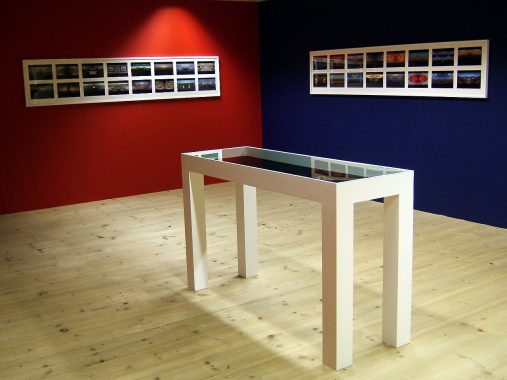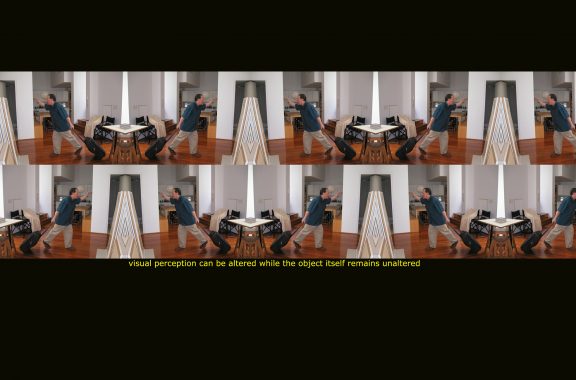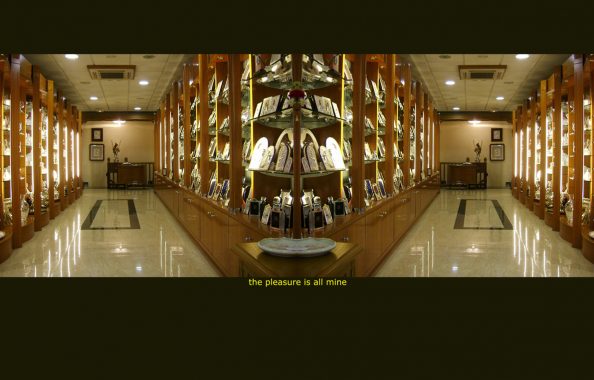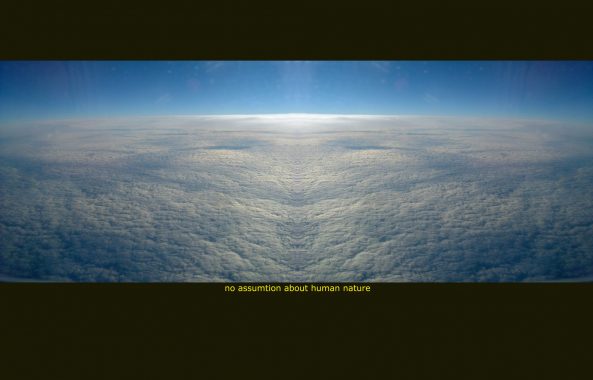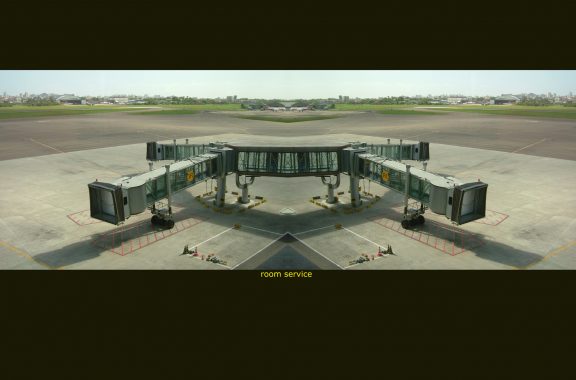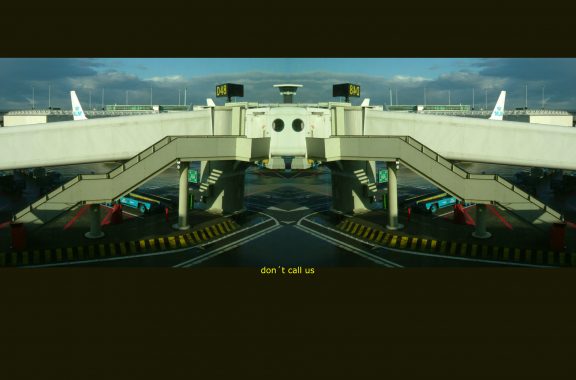Ann_Sofie Noring – Carlos Capelán Ceci n’est pas un video
Chief Curator, Museum of Modern Art, Stockholm, Sweden
Ceci n ‘est pas un video. This is not a video. No, this is not a video; it is a series of colour photographs arranged in two rows of eight image sequences, totalling 48 photographs. Each image is accompanied by a text fragment in English; the words are mounted as movie captions. But the images do not move; they are still, enigmatic.
Carlos Capelán’s art is multi-level led. With great versatility, he expresses that which is not easily expressed. A citizen of the world with rots in Uruguay and art studies in Sweden, he has worked and lived in many countries and in at least as many languages, and he has an unusually vast experience of seeing things from many angles. He has a reputation of being an outsider – but the question is, an outsider in relation to what? Where is the centre in t day’s world, and how do we define the periphery? Carlos Capelán’s works are structured as language, not one but a multitude; he builds on an existing vocabulary while simultaneously expanding its boundaries. Entering one of his installations is like setting foot in a silent and dense zone, charged with activity and meaning, and at the same time his works elude every attempt of categorization and interpretation. Pluralism, the play of opposites, is present in his life as well as in his work: Latin America and the Nordic Countries, the physical and the intellectual, the rational and the emotional. Based in graphic art and drawing, he has composed and combined two – dimensional images with objects, partly covered with clay, added words and quotations on walls and objects, expanded the room as if he wants to draw the entire world. Graphic art and earth art all in one. But in a time when installations have become the lingua franca of art, he has moved towards more classical modes of expression, such as painting.
In Ceci n ‘est pas un video he shows, for the first time, a work based on photography. The visual and conceptual dimensions are always present in Carlos Capelán’s works. The installation embraces us, lulls us into an almost ritualistic atmosphere, while simultaneously moving us away from the reassuring comfort of the central perspective by means of the many cross-connections that arise in his room. It is an intricate web of meaning, where fragments appear to those who move around and raise their eyes above the obvious. Wedged into Moderna Museet’s collection display we find Carlos Capelán’s pictorial suite, with a title that is a direct nod to the surrealist René Magritte, who painted the work Ceci n ‘est pas une pipe . No, it was not a pipe, as implied by the subject; it was – and is – a painting. At first, Ceci n ‘est pas un video appears to be 48 film stills, but it is not a film, it is stills taken with a digital camera. It is probable that the images were taken on the move by Carlos Capelán, perhaps leaving for or returning from his assignments of teaching students who all want to work with video, or perhaps taken on his way to one of the many biennials where video is the predominate medium. The work ‘s subtitle is do natives have a soul ,a question that undermines the ground further for too unambiguous interpretations. The subjects are mainly taken from airports, airplanes, runways and air spaces. In this no-man’s-land, far beyond the heaviness and darkness of exile, the natives have no place. No one belongs here, everything is in limbo. Carlos Capelán has interspersed his work with close-ups of pieces of raw meat, pizzas, and slices of sausages, presented with a distance equal to that covered by the flight. Each image is duplicated. As with Siamese twins, the subject is mirrored in itself, within the same frame. In a recent series of works, Capelán has explored the condition of jet lag; the state of weightlessness when the body is displaced, even though one knows that one is in one’s body. A common condition at the beginning of a new millennium.
Do you love me? Do you really love? it says on some of the captions with which Carlos Capelán has punctuated his images. Fuck off! is another succinct expression, but what it refers to is not immediately apparent. Many flight themes have longer captions in the manner of quotations from a book one ought to have read. Content arising from the work ‘s relationship with art history – yes, to a certain extent the reference to Magritte is expressive of the pictorial suite as a whole, but in the complex web that Carlos Capelán spins around us, it is only one of several possibilities. A structural and linguistic pluralism, everything is not possible, but most things are. Up to a point his works may be characterized as rhetorical, packed with statements, but the short circuits are innumerable and new meanings arise. It is like a film where the captions are out of sync and preferential rights of interpretation no longer exist, as life itself, for real, absurd, impossible, and fantastical. On a faceted image the artist pulls his suitcase back and forth with a text saying: Visual perception can be altered while the object itself remains unaltered. Everything depends on one’s chosen point of view.
Carlos Capelán once said t hat he wants to be a warm conceptual artist and a cold expressionist. The genre of portraiture has been a strong Western pictorial tradition, but instead of making portraits he chose, early on, to draw headless, multiplied bodies. Throughout his career he has used quotations from different Cultures, texts and signs, first in ink, and later drawn in ethereal fluids such as Coca-Cola, breast milk and wine. He is opposed to reduction and the aspiration towards simplified structures, characteristic of an old, colonial tradition. Instead he affirms plurality and polyphony. Multilingualness, where languages are seen as living organisms and the realization that the perfect translation does not exist – but in order to communicate we have to accept imperfection. Carlos Capelán places viewers in situations that encourage them to make their own decisions. Stay solid. Dematerialisation. Spatially, Ceci n ‘est pas un video is wedged into the museum collection and from the periphery the work poses questions to the museum as a whole.
Ann-Sofie Noring
Chief Curator, Museum of Modern Art, Stockholm, Sweden
